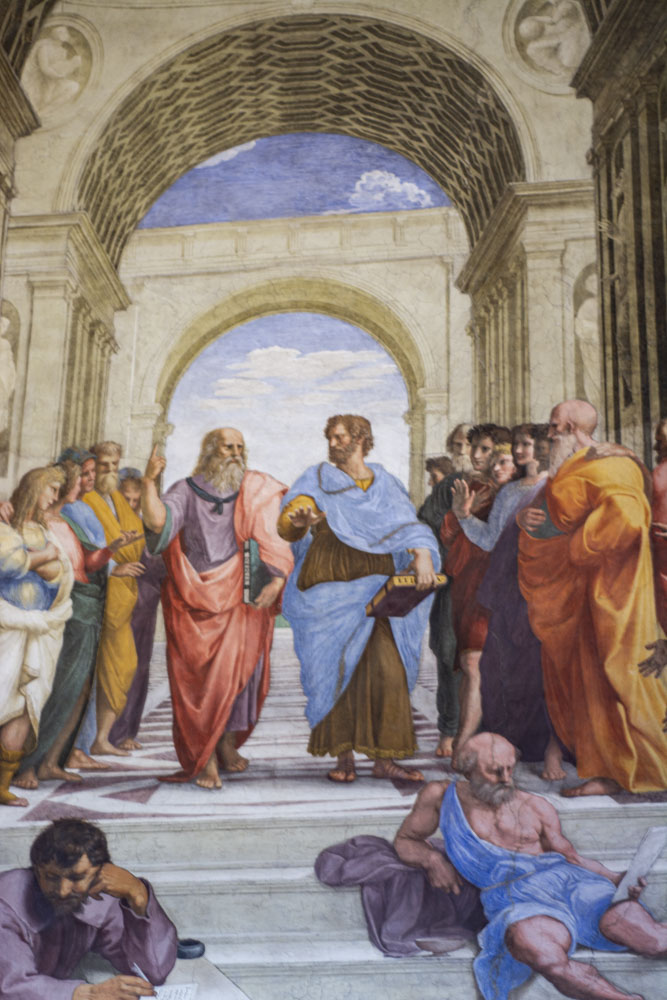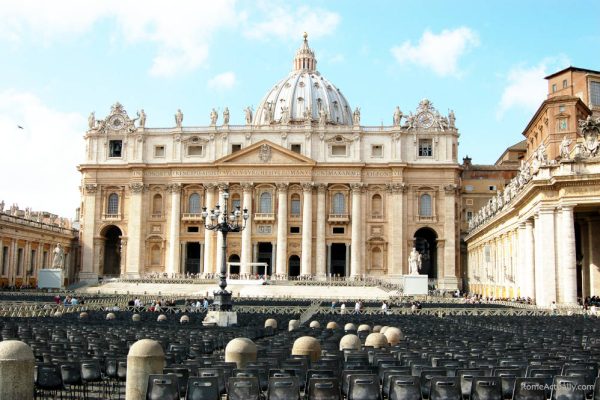Along with facing the long line at the entrance, one of the most overwhelming things about visiting the Vatican Museums is what actually to see. While attractions like the Sistine Chapel and the Gallery of the Maps are always listed among the unmissable highlights of the Vatican Museums, these wonderful century-old galleries have so much more to offer.
By far one of the most famous attractions in the Vatican, this large museum hosts a vast array of artwork and historical relics belonging to different eras that were either commissioned by the popes throughout five centuries or donated by world kings and leaders.
I have visited the Vatican Museums many times, and whenever I go, I like to dig deeper into a new section of it. While the Sistine Chapel’s charm is evergreen, there are so many things to see in the Vatican Museums that I often head to lesser-known attractions that are no less interesting and worth discovering.

The most famous highlights of the Vatican Museums
The Sistine Chapel
This is not the first attraction you will find on your way but it’s by far the most famous among the highlights of the Vatican Museums, one that is always included in the Vatican tours. Among the most popular tours of the Vatican Museums are those taking place early morning such as this one where you actually open the Museums, including the Sistine Chapel, and this one where you can enjoy a buffet breakfast in a courtyard of the museum. We recently joined a very exclusive private Vatican Museums tour and loved it as we were actually alone exploring the gallery and the Sistine Chapel.
The Sistine Chapel was named after Pope Sixtus IV della Rovere who had it restored between 1477 and 1480. The decorations made across the 15th century bear the names of important artists such as Sandro Botticelli, Domenico Ghirlandaio, and Pietro Perugino. In the early 16th century, when the pope was Julius II, the nephew of Sixtus IV, the full decoration of the ceiling was commissioned to the great Michelangelo Buonarroti. Almost 30 later, the same Michelangelo also painted the wall behind the altar with the world-famous Last Judgment.

The Last Judgment
Michelangelo’s Last Judgment huge fresco is the most famous painting in the Vatican Museums and is inside the Sistine Chapel. Painted in five years between 1536 and 1541, The Last Judgement covers the whole altar wall.
Thanks to the obstreperous temperament of its genius all-around artist, it’s linked to a number of historical anecdotes. Centered around the figure of Christ moments before God’s last judgment, in a sort of rotating movement, Michelangelo portrayed all the figures that are involved, from the Virgin Mary to Saint Peter and Saint Bartholomew, often regarded as the artist’s self-portrait.
The Borgia Apartment
This section of the Vatican Museums houses the apartments named after Pope Alexander VI born Rodrigo de Borja y Doms which we call “Borgia” in Italy. This is known as his apartment because it’s the area that was turned into his residence during his papacy from 1492 to 1503.
The Borgia Apartment comprises six main rooms that he renovated and redecorated including the Room of the Sybils, the Room of Liberal Arts, and the one of the Saints and the Mysteries. Along with the most monumental areas, there are also two smaller rooms probably used as the bedroom and the bathroom.
Borgia’s Apartment occupies the whole first floor of the Apostolic Palace but after he died, his successor Julius II abandoned the area in an effort to erase his memory and moved the new papal residence to the upper floor known as Raphael’s Rooms because they were decorated by the famous Renaissance painter Raphael.

Raphael’s Rooms
It’s out of doubt that Raphael’s Rooms are among the most famous highlights of the Vatican Museums, and no one visiting for the first time would skip them. Decorating the apartment chosen by Pope Julius II (pontiff from 1503 to 1513) as his residence, this is the masterpiece that indefinitely consecrated painter Raphael to immortality.
Painted by Raphael and pupils between 1508 and 1524, they are located on the second floor of the Papal Palace.
The Chapel of Urban VIII
This chapel was created in 1631 when Pope Urban VIII Barberini, the founder of the important Palazzo Barberini near the Trevi Fountain, built with the collaboration of some of the most famous artists and architects of the time, Carlo Maderno, Gian Lorenzo Bernini, and Francesco Borromini.
The pictorial decoration was entrusted to Florentine painter Alessandro Vaiani for the ceiling and the walls that portray the Passion of Christ, while Pietro da Cortona painted the altarpiece.

The Spiral Staircase
The stunning staircase you will likely climb in the Vatican Museums is a masterpiece often called “Bramante’s staircase” but mistakenly because it was built in 1932 following a project of architect Giuseppe Momo.
There is, in fact, another spiral staircase designed by Donato Bramante in the same premises of the Vatican Museums. It dates back to 1512 and it was built at the behest of Pope Julius II and is visible from the Gregorian Etruscan Museum.
Momo’s brilliant idea that we can see in the 20th-century construction was to build a double spiral ramp so that the visitors entering the museums and those leaving in the opposite direction would never meet. Apart from its great functionality, the spiral staircase is so beautiful that very few visitors forget to take great photos of it.
The Gallery of Geographical Maps
The Gallery of the Maps is another of the highlights of the Vatican Museums, one that is pretty much always included in the tours. This is a 120-meter corridor leading to the Sistine Chapel beautifully decorated with historical maps.
This is actually one of my favorite highlights of the Vatican Museums. I take my time to peruse these maps any chance I get. I have visited the Vatican Museums a few times and every time, I stop here to observe, read, and study these maps.
Apart from its aesthetical beauty, the appeal this gallery has to me is its historical value. Commissioned by Pope Gregory XIII, this corridor was built and set up between 1580 and 1585, and the frescoes were painted by Italian and Flemish artists. The direction, however, belonged to Ignazio Danti, an expert mathematician, astronomer, and cosmographer.
It took forty maps to cover the walls of the entire gallery and what’s portrayed is several Italian regions where the most important cities are highlighted with their own maps.

Gallery of the Tapestries
The area known as the Gallery of the Tapestries is decorated with Flemish tapestries crafted in Brussels by the workshop of Pieter van Aelst. They date back to the 16th century, more precisely to the time of Clement VII.
They were first exhibited in the Sistine Chapel in 1531 and set up for display in this Gallery in 1838, which makes them a piece of history, apart from displaying beautiful artwork.
Gallery of the Candelabra
The Gallery of the Candelabra takes its name from the monumental marble candelabra that is displayed combined with colored marble columns. This gallery was set up in the 18th century under the pontificate of Pius VI Braschi and redecorated under Leo XIII Pecci in the 19th century.

The Pinecone Courtyard
The Pinecone Courtyard is one of the highlights of the Vatican Museums that is located open-air and takes its name from the large bronze pinecone that pretty much dominates the view. This is a courtyard of about 300 square meters and one of the first areas you will see when visiting the museum because it leads to the different galleries and halls.
Octagonal Courtyard
This fantastic courtyard is also open-air and it has been the home to the classic art collection since its inception. In the early 16th century, Pope Julius II decorated this section with ancient statues with the aim of reviving Ancient Rome during the papal kingdom.
The Octagonal Courtyard underwent a few renovations across the centuries but some of the most important sculptures have been there since mid 16th century, including the beautiful Apollo Belvedere and Laocoön and His Sons.
Among the other statues that you can see in the courtyard are the 2nd-century River God (Arno), Perseus Triumphant made by Antonio Canova, and the Belvedere Hermes that was found in the gardens surrounding Castel Sant’Angelo (the Hadrian Mausoleum).

The Apollo Belvedere
This is by far one of the most famous statues of the Vatican Museums. The Apollo Belvedere has been decorating the Octagonal Courtyard since at least 1508 and according to researchers, it was made around the 2nd century probably as a replica of a bronze sculpture of the 4th century BC by an artist of the Mausoleum of Halicarnassus.
Laocoön and His Sons
Another one of the most famous sculptures in the Vatican Museums, Laocoön and His Sons is located in the Octagonal Court.
This wonderful statuary group has been identified as the masterpiece of the Rhodes sculptors Agesandros, Athanodoros and Polydoros as described by Roman writer and general Pliny.

The Carriage Pavilion
This is a very interesting attraction inside the Vatican Museum premises because of its historical value. While much of the highlights of the Vatican Museums bear artistic worth, this area enshrines a piece of history.
Walking its corridors, you can see the old carriages used by the popes to travel up to the most modern “popemobiles” by the most famous car producers from Mercedes Benz to Fiat to Toyota and Land Rover.
Pinacoteca
This important art gallery within the Vatican Museums displays around 500 paintings over 18 rooms. Among the artists displayed are some of the most important Italian painters including Caravaggio, Giotto, Beato Angelico, Raphael, Leonardo Da Vinci, and Titian.
Don’t miss our guide to the best restaurants near the Vatican.
The Gregorian Egyptian Museum
This gallery is particularly interesting because it seeks to shed light on the connection between Rome and Egypt by displaying a rich collection of tools and objects from Roman Egypt and an Egyptian-influenced Rome.
In imperial times, in fact, several monuments and decorative objects and patterns were brought to Rome from Egypt to embellish notable villas, buildings, and even sanctuaries. Some of the ornaments were used to decorate the Horti Sallustiani, the ancient villa that belonged to the historian Sallustio.
Similarly, there are several Egyptian-inspired works by Roman craftsmen, such as findings from Hadrian’s Villa in Tivoli, iconic to the influence the Pharaonic culture and civilization had in Rome.
The Gregorian Etruscan Museum
Pope Gregory XVI founded this fascinating museum dedicated to Etruscan antiquities in the 19th century and displays relics found in some of the most important cities of ancient Etruria, including those in the territory of the Papal State.
You will be able to travel through the thousand-year-old Etruscan civilization from the Iron Age all the way through their definitive integration within Roman rule. There are also Roman artifacts including bronze, glass, ceramic, and terracotta pieces that cover several centuries up to the end of the Western Empire in the 5th century.

The Pio Clementino Museum
This gallery is one of the highlights of the Vatican Museums and shows a large collection of classical sculptures mainly gathered during the 18th century.
Originally, the statues were displayed in the formerly-named “Courtyard of the Statues” that is now the Octagonal Courtyard. Currently, the museum has been named after its two founders, popes Clemens XIV and Pius VI.
The Profane Museum
The Profane Museum gathers and displays the precious artifacts of the Vatican such as medals, jewelry, cameos, and crystals. This has long been one of the highlights of the Vatican Museums for the beauty of the objects on display and for the location as it’s on the route most tours go by.
Check out our guide to the best hotels near the Vatican!
WANT TO SAVE THIS FOR LATER? PIN IT TO YOUR BOARD!







